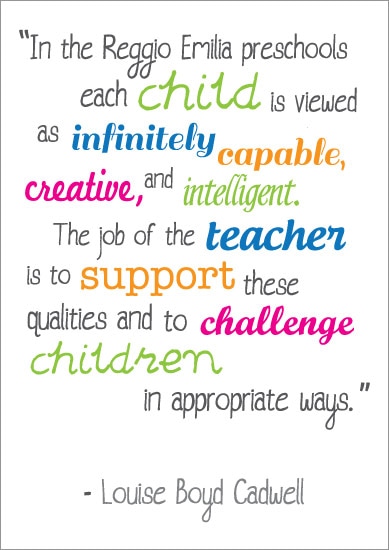Reggio Emilia
The Reggio Emilia approach to early childhood education has been hailed as one of the best preschool approaches in the world by Newsweek magazine. To date, Reggio has attracted the worldwide attention of educators, researchers and just about anyone interested in early childhood education best practices.
The Reggio Emilia approach to early childhood education is based on over forty years of experience in the Reggio Emilia Municipal Infant/toddler and Preschool Centers in Italy. It places emphasis on children’s symbolic languages in the context of a project-oriented curriculum. Learning is viewed as a journey; and education as building relationships with people (both children and adults) and creating connections between ideas and the environment. Through this approach, adults help children understand the meaning of their experience more completely through documentation of children’s work, observations, and continuous teacher-child dialogue. Reggio approach guides children’s ideas with provocations—not predetermined curricula. There is collaboration on many levels: parent participation, teacher discussions, and community.
Reggio Emilia Approach is based on a comprehensive philosophy, underpinned by several fundamental, guiding principles:
● The child as protagonist, collaborator, and communicator.
● The teacher as partner, nurturer, guide, and researcher.
● Cooperation as the foundation of the educational system.
● The environment as the “third teacher.”
● The Parent as Partner
● Documentation as communication.
The Teacher
The teacher in Reggio Emilia is the researcher, the data gatherer, the learner, and the strategic contributor to the child’s capacity to learn. The responsibility is on the community of teachers to provide the contexts for learning. The curriculum emerges with purpose, direction, and detail. Teachers constantly gather information about what is emerging. The role of the teacher is not just to impart facts and knowledge. The role of the teacher is to help children come to understand the relationships of things around them to themselves.
The Environment
Each classroom is designed to support the Reggio Emilia approach as well as allowing opportunities for physical exploration and imaginative play. In Reggio Emilia, the environment is often referred to as the third teacher. The aesthetics are simple and homelike with attention paid to ensure that there is a purpose for all things introduced to the environment. As in a typical elementary classroom you do not find brightly colored posters or signs. A space designed solely for creative endeavors called the "Atelier" or Artist Studio is where the children can visually express their interpretations of the world. A large climbing fort and other smaller play lofts are great places for kids to expend energy or provide smaller more childlike spaces for quite play. Our classrooms are also designed as flexible spaces with equipment that is moveable allowing for a changing environment. Our approach to the school environment embodies educators’ belief that children are resourceful, curious, competent, imaginative, and have a desire to interact with and communicate with others.
The Reggio Emilia approach to early childhood education is based on over forty years of experience in the Reggio Emilia Municipal Infant/toddler and Preschool Centers in Italy. It places emphasis on children’s symbolic languages in the context of a project-oriented curriculum. Learning is viewed as a journey; and education as building relationships with people (both children and adults) and creating connections between ideas and the environment. Through this approach, adults help children understand the meaning of their experience more completely through documentation of children’s work, observations, and continuous teacher-child dialogue. Reggio approach guides children’s ideas with provocations—not predetermined curricula. There is collaboration on many levels: parent participation, teacher discussions, and community.
Reggio Emilia Approach is based on a comprehensive philosophy, underpinned by several fundamental, guiding principles:
● The child as protagonist, collaborator, and communicator.
● The teacher as partner, nurturer, guide, and researcher.
● Cooperation as the foundation of the educational system.
● The environment as the “third teacher.”
● The Parent as Partner
● Documentation as communication.
The Teacher
The teacher in Reggio Emilia is the researcher, the data gatherer, the learner, and the strategic contributor to the child’s capacity to learn. The responsibility is on the community of teachers to provide the contexts for learning. The curriculum emerges with purpose, direction, and detail. Teachers constantly gather information about what is emerging. The role of the teacher is not just to impart facts and knowledge. The role of the teacher is to help children come to understand the relationships of things around them to themselves.
The Environment
Each classroom is designed to support the Reggio Emilia approach as well as allowing opportunities for physical exploration and imaginative play. In Reggio Emilia, the environment is often referred to as the third teacher. The aesthetics are simple and homelike with attention paid to ensure that there is a purpose for all things introduced to the environment. As in a typical elementary classroom you do not find brightly colored posters or signs. A space designed solely for creative endeavors called the "Atelier" or Artist Studio is where the children can visually express their interpretations of the world. A large climbing fort and other smaller play lofts are great places for kids to expend energy or provide smaller more childlike spaces for quite play. Our classrooms are also designed as flexible spaces with equipment that is moveable allowing for a changing environment. Our approach to the school environment embodies educators’ belief that children are resourceful, curious, competent, imaginative, and have a desire to interact with and communicate with others.

